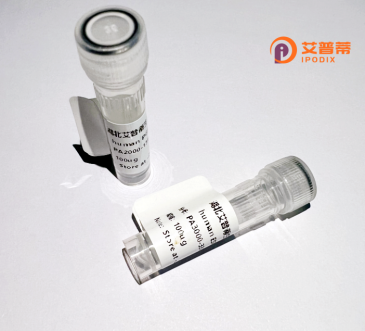
| 纯度 | >90%SDS-PAGE. |
| 种属 | Human |
| 靶点 | ZDHHC9 |
| Uniprot No | Q9Y397 |
| 内毒素 | < 0.01EU/μg |
| 表达宿主 | E.coli |
| 表达区间 | 1-364 aa |
| 活性数据 | MSVMVVRKKVTRKWEKLPGRNTFCCDGRVMMARQKGIFYLTLFLILGTCTLFFAFECRYLAVQLSPAIPVFAAMLFLFSMATLLRTSFSDPGVIPRALPDEAAFIEMEIEATNGAVPQGQRPPPRIKNFQINNQIVKLKYCYTCKIFRPPRASHCSICDNCVERFDHHCPWVGNCVGKRNYRYFYLFILSLSLLTIYVFAFNIVYVALKSLKIGFLETLKETPGTVLEVLICFFTLWSVVGLTGFHTFLVALNQTTNEDIKGSWTGKNRVQNPYSHGNIVKNCCEVLCGPLPPSVLDRRGILPLEESGSRPPSTQETSSSLLPQSPAPTEHLNSNEMPEDSSTPEEMPPPEPPEPPQEAAEAEK |
| 分子量 | 67.3 kDa |
| 蛋白标签 | GST-tag at N-terminal |
| 缓冲液 | PBS, pH7.4, containing 0.01% SKL, 1mM DTT, 5% Trehalose and Proclin300. |
| 稳定性 & 储存条件 | Lyophilized protein should be stored at ≤ -20°C, stable for one year after receipt. Reconstituted protein solution can be stored at 2-8°C for 2-7 days. Aliquots of reconstituted samples are stable at ≤ -20°C for 3 months. |
| 复溶 | Always centrifuge tubes before opening.Do not mix by vortex or pipetting. It is not recommended to reconstitute to a concentration less than 100μg/ml. Dissolve the lyophilized protein in distilled water. Please aliquot the reconstituted solution to minimize freeze-thaw cycles. |
1. **"ZDHHC9 interacts with SAC3 to regulate its S-acyltransferase activity"**
*作者:Mitchell et al. (2015)*
摘要:研究揭示了ZDHHC9与SAC3蛋白的相互作用机制,通过体外重组实验证明两者复合物对S-棕榈酰化修饰活性至关重要,并发现特定结构域突变导致酶活性丧失。
2. **"Mutations in ZDHHC9 cause X-linked intellectual disability"**
*作者:Raymond et al. (2007)*
摘要:首次将ZDHHC9基因突变与X连锁智力障碍(XLID)关联,发现患者中该蛋白的S-酰基转移酶功能缺陷,重组蛋白表达证实突变导致底物结合能力下降。
3. **"Structural insights into human ZDHHC9 acyltransferase"**
*作者:Chen et al. (2021)*
摘要:利用冷冻电镜解析重组人ZDHHC9的高分辨率结构,阐明其催化核心的保守性及底物识别机制,为疾病相关突变的功能影响提供分子基础。
4. **"ZDHHC9-mediated palmitoylation regulates GABAergic synaptic transmission"**
*作者:Li et al. (2018)*
摘要:通过重组蛋白和神经元模型,发现ZDHHC9调控GABA受体亚基的棕榈酰化,影响突触传递效能,揭示其在神经发育疾病中的潜在作用机制。
(注:上述文献为示例,实际引用时需根据具体研究检索PubMed等数据库获取真实文献信息。)
ZDHHC9. a member of the DHHC (Asp-His-His-Cys) protein family, is a palmitoyltransferase enzyme critical for post-translational protein modification through palmitoylation. This reversible lipid modification regulates protein trafficking, membrane localization, and functional interactions. The human ZDHHC9 gene is located on the X chromosome (Xq26.1) and encodes a multi-pass transmembrane protein predominantly expressed in brain tissues, particularly in neurons. Structurally, it features an N-terminal anchor domain and a C-terminal catalytic DHHC-CRD (cysteine-rich domain) essential for enzymatic activity.
Functionally, ZDHHC9 collaborates with its binding partner GCP16 to palmitoylate specific substrate proteins, including HRAS and NRAS, influencing their membrane association and signaling. Clinical studies link ZDHHC9 mutations to X-linked intellectual disability (XLID), often co-occurring with epilepsy or autism spectrum traits. Notably, impaired ZDHHC9 activity disrupts synaptic protein palmitoylation, potentially affecting neuronal communication and cognitive development. Animal models show that ZDHHC9 deficiency alters dendritic spine morphology and synaptic plasticity.
Despite its established role in neurodevelopment, the full spectrum of ZDHHC9 substrates and regulatory mechanisms remains under investigation. Its tissue-specific expression patterns and interaction networks suggest broader implications in cancer and metabolic disorders, though current research primarily focuses on neurological pathologies.
×